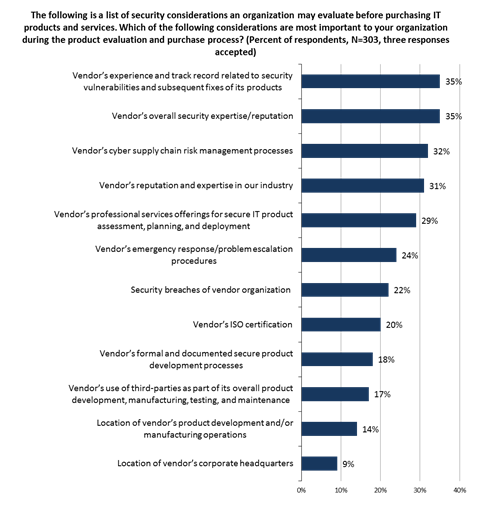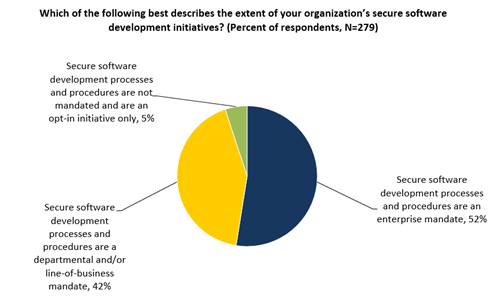The Critical Infrastructure Cybersecurity Landscape
Today’s Outlook on Cybersecurity Threats More Bleak than in 2013
Defending against cyber-attacks represents a perpetual battle for critical infrastructure organizations facing an increasingly dangerous threat landscape. In fact, 31% of security professionals working at critical infrastructure organizations believe that the threat landscape today is much worse than it was two years ago, while another 36% say it is somewhat worse (see Figure 1).
It is interesting to note that ESG asked this same question in its 2010 research project,1 and it produced strikingly similar results—68% of respondents said that the threat landscape was worse in 2010 compared with 2008. Clearly, the threat landscape is getting more hazardous on an annual basis with no letup in sight. ESG finds this data particularly troubling. U.S. citizens depend upon critical infrastructure organizations for the basic necessities of modern society like food, water, fuel, and telecommunications services. Given the increasingly dangerous threat landscape, critical infrastructure organizations are tasked with maintaining important everyday services and defending their networks from a growing army of cyber-criminals, hacktivists, and nation state actors.
Note1: Source: ESG Research Report, Assessing Cyber Supply Chain Security Vulnerabilities Within the U.S. Critical Infrastructure, November 2010.

These beliefs about the increasingly dangerous threat landscape go beyond opinions alone as many critical infrastructure organizations face constant cyber-attacks. A majority (68%) of critical infrastructure organizations experienced a security incident over the past two years, with nearly one-third (31%) experiencing a system compromise as a result of a generic attack (i.e., virus, Trojan, etc.) brought in by a user’s system, 26% reporting a data breach due to lost/stolen equipment, and 25% of critical infrastructure organizations suffering some type of insider attack (see Figure 2). Alarmingly, more than half (53%) of critical infrastructure organizations have dealt with at least two of these security incidents since 2013.

Security incidents always come with ramifications associated with time and money. For example, nearly half (47%) of cybersecurity professionals working at critical infrastructure organizations claim that security incidents required significant IT time/personnel for remediation. While this places an unexpected burden on IT and cybersecurity groups, other consequences related to security incidents were far more ominous—36% say that security incidents led to the disruption of a critical business process or business operations, 36% claim that security incidents resulted in the disruption of business applications or IT systems availability, and 32% report that security incidents led to a breach of confidential data (see Figure 3).
This data should be cause for concern since a successful cyber-attack on critical infrastructure organizations’ applications and processes could result in the disruption of electrical power, health care services, or the distribution of food. Thus, these issues could have a devastating impact on U.S. citizens and national security.

Cybersecurity at Critical Infrastructure Organizations
Do critical infrastructure organizations believe they have the right cybersecurity policies, processes, skills, and technologies to address the increasingly dangerous threat landscape? The results of that inquiry are mixed at best. On the positive side, 37% rate their organizations’ cybersecurity policies, processes, and technologies as excellent and capable of addressing almost all of today’s threats. It is worth noting that the overall ratings have improved since 2010 (see Table 1). While this improvement is noteworthy, 10% of critical infrastructure security professionals still rate their organization as fair or poor.
Being able to deal with most threats may be an improvement from 2010, but it is still not enough. This is especially true given the fact that the threat landscape has grown more difficult at the same time. Critical infrastructure organizations are making progress, but defensive measures are not progressing at the same pace as the offensive capabilities of today’s cyber-adversaries and this risk gap leaves all U.S. citizens vulnerable.
| How would you rate your organization’s security policies, procedures,and technology safeguards in their ability to address the current threat landscape? | ||
|---|---|---|
| 2010 (N=285) | 2015 (N=303) | |
| Excellent, capable of addressing almost all of today’s threats | 22% | 37% |
| Good, capable of addressing most of today’s threats | 56% | 54% |
| Fair, capable of addressing only some of today’s threats | 18% | 9% |
| Poor, capable of addressing few of today’s threats | 2% | 1% |
| Don’t know/no opinion | 2% | 0% |
Given the national security implications of critical infrastructure, it is not surprising that cybersecurity risk has become an increasingly important board room issue over the past five years. Nearly half (45%) of cybersecurity professionals today rate their organization’s executive management team as excellent, while only 25% rated them as highly in 2010 (see Table 2). Alternatively, 10% rate the executive management team’s cybersecurity commitment as fair or poor in 2015, where 23% rated them so in 2010. These results are somewhat expected given the visible and damaging data breaches of the past few years. Critical infrastructure cybersecurity is also top of mind in Washington with legislators, civilian agencies, and the executive branch. For example, the 2014 National Institute of Standards and Technology (NIST) cybersecurity framework (CSF) was driven by an executive order and is intended to help critical infrastructure organizations measure and manage cyber-risk more effectively. As a result of all of this cybersecurity activity, corporate boards are much more engaged in cybersecurity than they were in the past, but whether they are doing enough or investing in the right areas is still questionable.
| In your opinion, how would you rate your organization’s executive management team on its willingness to invest in and support cybersecurity initiatives? | ||
|---|---|---|
| 2010 (N=285) | 2015 (N=303) | |
| Excellent, executive management is providing the optimal level of investment and support | 25% | 45% |
| Good, executive management is providing an adequate level of investment and support, but we could use more | 49% | 45% |
| Fair, executive management is providing some level of investment and support, but we could use much more | 21% | 9% |
| Poor, executive management is not providing the right level of investment and support and we could use much more | 2% | 1% |
| Don’t know/no opinion | 3% | 0% |
Critical infrastructure organizations are modifying their cybersecurity strategies for a number of reasons. For example, 37% say that their organization’s infosec strategy is driven by the need to support new IT initiatives with strong security best practices. This likely refers to IT projects for process automation that include Internet of Things (IoT) technologies. IoT projects can bolster productivity, but they also introduce new vulnerabilities and thus the need for additional security controls. Furthermore, 37% point to protecting sensitive customer data confidentiality and integrity, and 36% call out the need to protect internal data confidentiality and integrity (see Figure 4). These are certainly worthwhile goals, but ESG was surprised that only 22% of critical infrastructures say that their information security strategy is being driven by preventing/detecting targeted attacks and sophisticated malware threats. After all, 67% of security professionals believe that the threat landscape is more dangerous today than it was two years ago, and 68% of organizations have suffered at least one security incident over the past two years. Since critical infrastructure organizations are under constant attack, ESG feels strongly that CISOs in these organizations should be assessing whether they are doing enough to prevent, detect, and respond to modern cyber-attacks.

Cyber Supply Chain Security
Like many other areas of cybersecurity, cyber supply chain security is growing increasingly cumbersome. In fact, 60% of security professionals say that cyber supply chain security has become either much more difficult (17%) or somewhat more difficult (43%) over the last two years (see Figure 5).

Why has cyber supply chain security become more difficult? Forty-four percent claim that their organizations have implemented new types of IT initiatives (i.e., cloud computing, mobile applications, IoT, big data analytics projects, etc.), which have increased the cyber supply chain attack surface; 39% say that their organization has more IT suppliers than it did two years ago; and 36% state that their organization has consolidated IT and operational technology security, which has increased infosec complexity (see Figure 6).
This data is indicative of the state of IT today. The fact is that IT applications, infrastructure, and products are evolving at an increasing pace, driving dynamic changes on a constant basis and increasing the overall cyber supply chain attack surface. Over-burdened CISOs and infosec staff find it difficult to keep up with dynamic cyber supply chain security changes, leading to escalating risks.



























